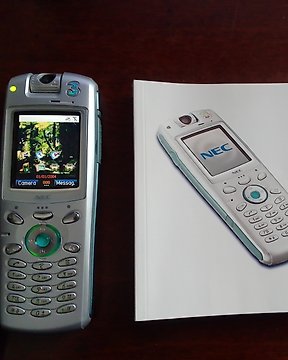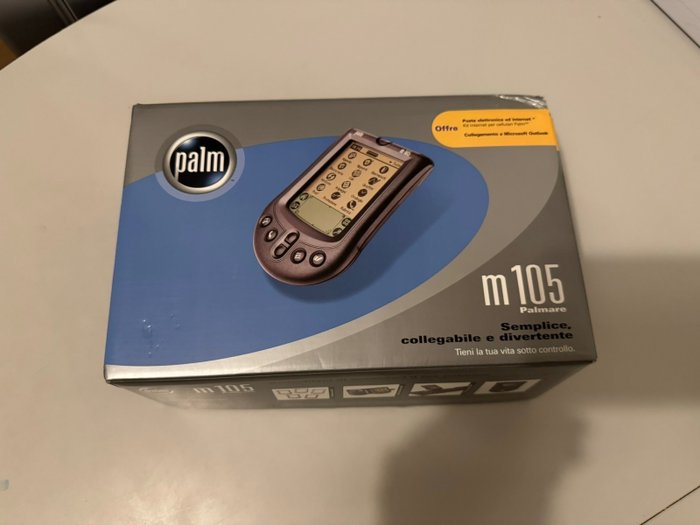
NEC - Telemóvel - Na caixa original
N.º 82885463

N.º 82885463

Introduction:
BrandBrand name of the device. This may match with the manufacturer Palm
ModelOne or more (separated by /) specific model name identifies this device. This field often includes Model Code too which can be separated m105
ReleasedFirst official market release date in (year, month) 2001 Mar 6
Hardware DesignerThe company which designed this device Palm
ManufacturerThe company which produces this device Palm
General ExtrasHardware extras like stylus, kickstand, rotatatble screen, rotatable keyboard, haptic feedback, etc. Passive stylusStylus in default package
Device CategorySmartphone, tablet, smart watch, PDA, palmtop, etc. PDAPersonal Digital Assistant is a palm-sized, touchscreen mobile computer which is able to natively run third-party apps. It has neither cellular modem nor large-scaled physical keybaord.
Collapse datasheetExpand datasheet | Add this item to the comparisonAdd to compare
Physical AttributesPhysical Attributes:
WidthWidth is horizontally measured between the left and right edges of device according to the default display orientation 79.2 mm
HeightHeight is vertically measured between the bottom and top edges of device according to the default display orientation 118.4 mm
DepthDepth refers to the thickness of the device. Depth is usually the smallest dimension of the device 18.3 mm
DimensionsAll dimensions are maximal values (measured between the furthest points of the device) in closed state 3.12x4.66x0.72 inches
MassThe mass of the device including standard battery and stylus (if any and it can be inserted into the device) measured in grams 125 g
4.41 ouncesThe mass of the device including standard battery and stylus (if any and it can be inserted into the device) measured in ounces
Software EnvironmentSoftware Environment:
PlatformThe family of the operating system like Android, iOS, Windows Phone/Mobile, Palm OS, etc. Palm OS
Operating SystemPre-installed (usually embedded) operating system which the device was released with. Palm Computing Palm OS 3.5Palm Computing Palm OS 3.5
(3.5.1)Subversion, update version, user interface, defualt language, etc.
Application processor, ChipsetApplication processor, Chipset:
CPU ClockFrequency of the square signal which schedules the internal operation of microprocessor (synchronous sequential logic). The current consumed by the processor is approximately proportional to clock rate. 16 MHz
CPUManufacturer part number and most important characteristics of the IC which includes the main application processor or processors Motorola DragonBall EZ MC68EZ328 (Red Dragon), 1998, 32 bit, single-coreMotorola DragonBall EZ MC68EZ328 (Red Dragon), 1998, 32 bit, single-core
Operative MemoryOperative Memory:
RAM TypeType of volatile memory IC which specifies RAM architecture, timing characteristics, refresh mode, voltage levels and physical design of the IC. Two major types of random-access memory is static RAM (SRAM) periodically refreshed dynamic RAM (DRAM). EDO DRAM
RAM Capacity (converted)RAM capacity in binary bytes (KiB: 1024 bytes, MiB: 1024 KiB, GiB: 1024 MiB) 8 MiB RAM
Non-volatile MemoryNon-volatile Memory:
Non-volatile Memory InterfaceInterface (e.g. UFS 2.0, eMMC 5.1, moviNAND) which determines physical layer (width, clock rate, lanes, protocol) of data transfer between the application processor and the NV memory Yes
Non-volatile Memory Capacity (converted)The value of ROM capacity converted to the most appropriate units (KiB: 1024 bytes, KB: 1000 bytes, MiB: 1024 KiB, MB: 1000 KB, GiB: 1024 MiB, GB: 1000 MB) 2 MiB ROM
DisplayDisplayAll parameters that related to display
Display DiagonalThe distance measured between the furthest corners of the display. In case of display with rounded edges this refers to the diagonal of the smallest bounding rectangle. 70 mm
2.8 inchDisplay Diagonal in inches
ResolutionHorizontal and vertical resolution of the primary display. In case of display with rounded edges this refers to the smallest bounding rectangle. 160x160
Horizontal Full Bezel WidthDefined as the sum of width of left and right vertical display bezels. If the display panel is located in the middle width of left and right bezels are the same and their width is the half of the full bezel width. 29.7 mm
Display Area UtilizationRegular display area per regular front panel area ratio. This approximated indicator does not count with possible rounded corners (neither on front panel nor on display) or display notches, holes. 26.1%
Pixel DensityIndicates the number of pixels per inch 82 PPI
Display TypeDisplay technology, e.g. Color/ monochrome e-ink, STN, PM-OLED, AM-OLED, TN-TFT, IPS TFT, ASV TFT, MVA TFT, PVA TFT, PLS TFT MSTN LCDGrey/monochrome STN (super-twisted nematic). This is a passive matrix LCD (Liquid Crystal Display) technology. display
Number of Display ScalesMaximal number of displayable colors or scales 16
Scratch Resistant ScreenUsual types: Gorilla Glass generations, DragonTrail/X, Sapphire Glass No
Collapse datasheetExpand datasheet
Graphical SubsystemGraphical Subsystem:
Graphical ControllerManufacturer and part number of the graphics controller IC or commercial name of the intellectual property (IP) if the graphics controller is the part of a chipset N/A
Audio/Video InterfacesAudio/Video Interfaces:
A/V OutAudio/Video outputs form a heterogeneous group of interfaces that allow the user to connect the device to various external analog/digital multimedia devices (monitors, projectors, HD TVs) and play multimedia content. For example: MHL, DisplayPort, HDMI, e No
Audio SubsystemAudio Subsystem:
Microphone(s)Analog or digital sound receiver. Main applications: voice calls, active noise cancellation, voice command, voice/video recording, voice identification No
Loudspeaker(s): mono
Audio Output: No
Cellular PhoneCellular Phone:
Supported Cellular BandsList of supported cellular networks with band names. For example GSM900 refers to the GSM system with the 890-915 MHz uplink and 935-960 downlink bands. No
Secondary Cellular PhoneSecondary Cellular Phone:
Sec. Supported Cellular Networks: No
Control PeripheralsControl Peripherals:
Touchscreen TypeDetermines how the touchscreen module senses the touch of the screen Resistive screen
Directional PadA four-way mechanism that allows the selection of certain on-screen objects 2-way
Communication InterfacesCommunication Interfaces:
Expansion InterfacesNon-volatile memory and/or I/O expansion interfaces. For example: microSD, microSDXC, SDHC, CF II., PCMCIA III., etc. No
USBFirst or the only USB port. USB is a common high-speed serial bus standard that allows data and power transfer between the mobile device and another computer. Version of USB identifies USB standard. No
NoDetermines the highest available data transfer speed of first USB port. Usual standard speed levels: High-Speed (HS), Super-Speed (SS)
USB ConnectorPhysical USB connector layout. Most common types: micro-USB, USB A, USB Type-C or proprietary (e.g. Lightning) No
BluetoothIEEE 802.15 is a short-range radio technology standard that allows transfer of data, and the use of accessories such as wireless audio devices and printers. This field specifies the supported BT version. No
Wireless LANWireless LAN / WLAN / Wi-Fi: 802.11 defines a medium-range wireless data link that allows for internet access and data transfer. This field enumerates the supported protocols (e.g. 802.11a/b/g/n). No
IRInfrared Port (IR): Near-field (within 1 meter) wireless optical data link mainly for connecting mobile devices, accessories and consumer electronic devices (remote control). IrDA 1.1
115200bit/s (SIR/CIR)Determines the highest available data transfer speed of IR port
SerialUniversal Asynchronous Receiver-Transmitter (UART) is a configurable asynchronous serial data link RS-232
Serial Connector: Proprietary
Serial Data Rate: 115200 bps
Multimedia BroadcastMultimedia Broadcast:
FM Radio ReceiverWith a bulit-in FM radio the device is able to receive FM (frequency modulated) broadcast in 79 - 108 MHz band. No
Satellite NavigationSatellite Navigation:
Primary Camera SystemPrimary Camera SystemPrimary camera usually has better imaging capabilities than secondary camera if any
Camera Image SensorRefers to the semiconductor technology of image sensor (FSI CMOS, BSI CMOS, etc.) No
FocusCD AF, PD AF, Laser AF, etc. No / Not supported means there is no adjustable optical system or no camera built-in at all No
FlashA flash is used to brighten dark areas when taking photographs; is also used as a flashlight. This field contains the exact type of the flash. No
Aux. Camera Image SensorAuxiliary camera image sensor technology in at least dual lens setup No
Aux. 2 Camera Image SensorAuxiliary 2 camera image sensor technology in at least triple lens setup No
Aux. 3 Camera Image SensorAuxiliary 3 camera image sensor technology in at least quad lens setup No
Aux. 4 Camera Image SensorAuxiliary 4 camera image sensor technology in at least penta lens setup No
Secondary Camera SystemSecondary Camera SystemWidely used for video telephony or taking selfies
Secondary Camera SensorRefers to the semiconductor technology of sec camera image sensor (FSI CMOS, BSI CMOS, etc.) No
Sec. Aux. Cam. Image SensorImage sensor technology of sec. auxiliary camera in at least dual lens secondary camera setup No
Built-in SensorsBuilt-in Sensors:
Built-in accelerometerAn internal component that senses acceleration components of the device. Used for automatic screen rotation and for games and applications that rely on acceleration measurement on X, Y, and Z axis. Possible types: 1D, 2D, 3D No
Collapse datasheetExpand datasheet
Ingress ProtectionIngress Protection:
Protection from solid materialsIngress Protection Standards. IP First digit: Protection from solid objects or materials Yes
Protection from liquidsIngress Protection Standards. IP Second digit: Protection from liquids Yes
Power SupplyPower Supply:
BatteryBattery technology AAA pencil battery
removablePossible options: removable, built-in
1-cellIn case of high power consumption it is more efficient to connect more than 1 cells in the battery in series to minimize current thus loss.
Estimated Battery LifeEstimated always-on battery life of the device in case of common usage conditions 40.0 hours
Geographical AttributesGeographical Attributes:
Market CountriesCountries where the device was officially sold. Overlap is possible. USA
Datasheet AttributesDatasheet Attributes:
Data IntegrityData integrity level determines the integrity of the published information. Final datasheets are not intended to be modified in the future, preliminary ones can be based on unofficial information or speculations, incomplete ones are also preliminary b Final
AddedThe exact time of the datasheet addition 2008-02-28 16:24 Attention, there are signs of use, scratches, cracks as in the photo, etc. Attention, the kit includes everything you see in the photo
Como comprar na Catawiki
1. Descubra algo especial
2. Faça a licitação vencedora
3. Faça um pagamento seguro